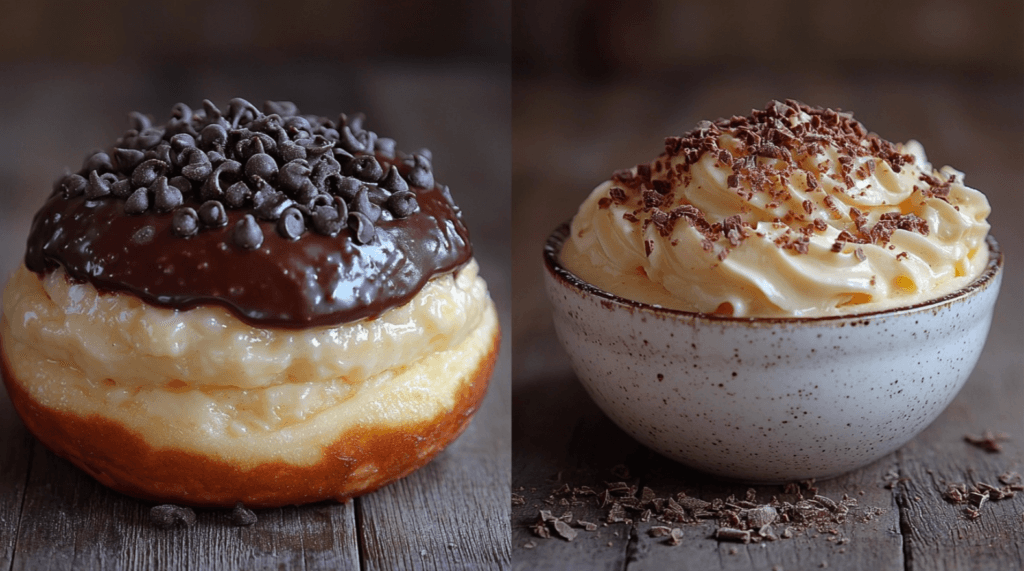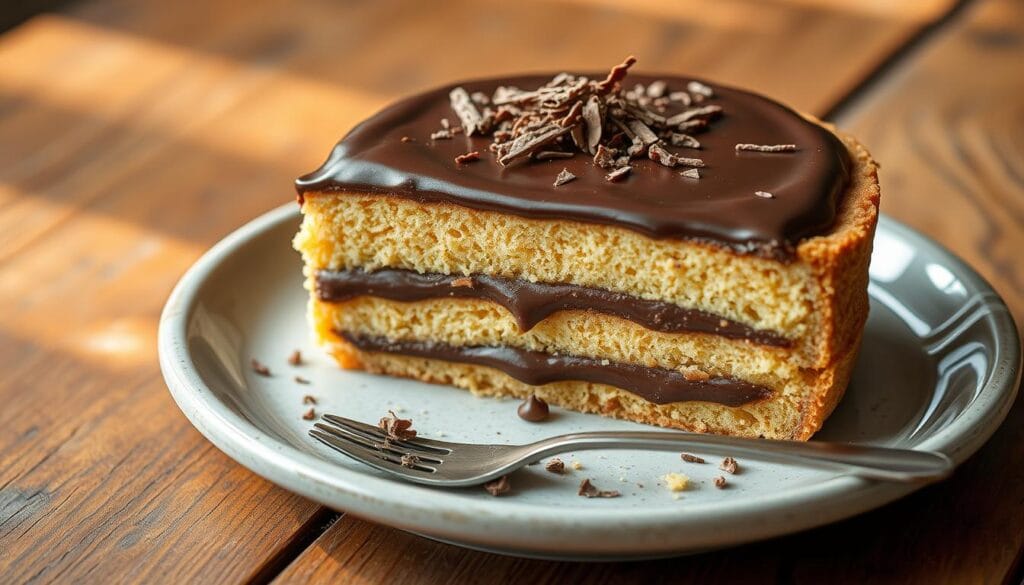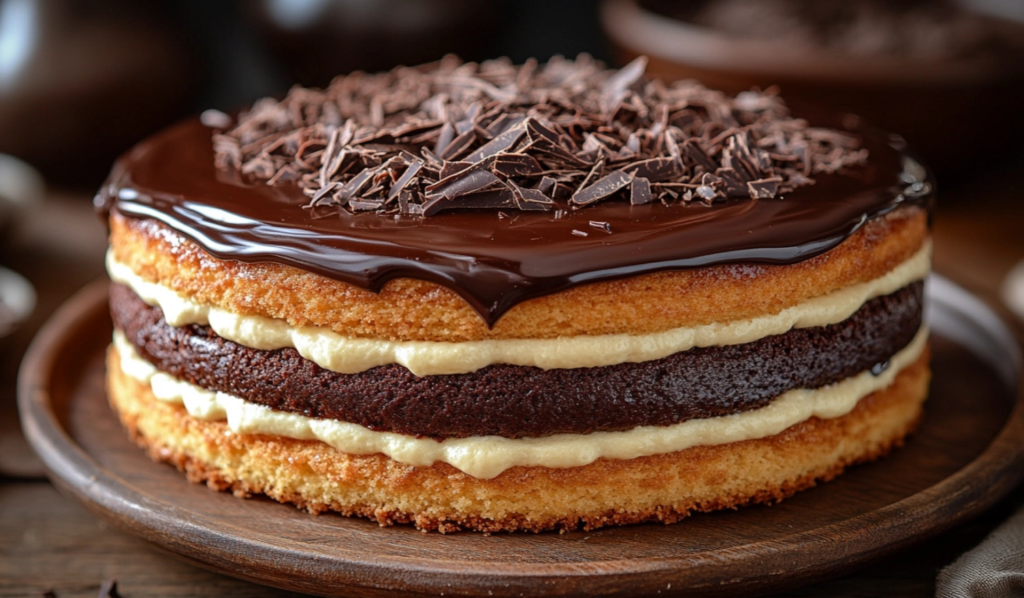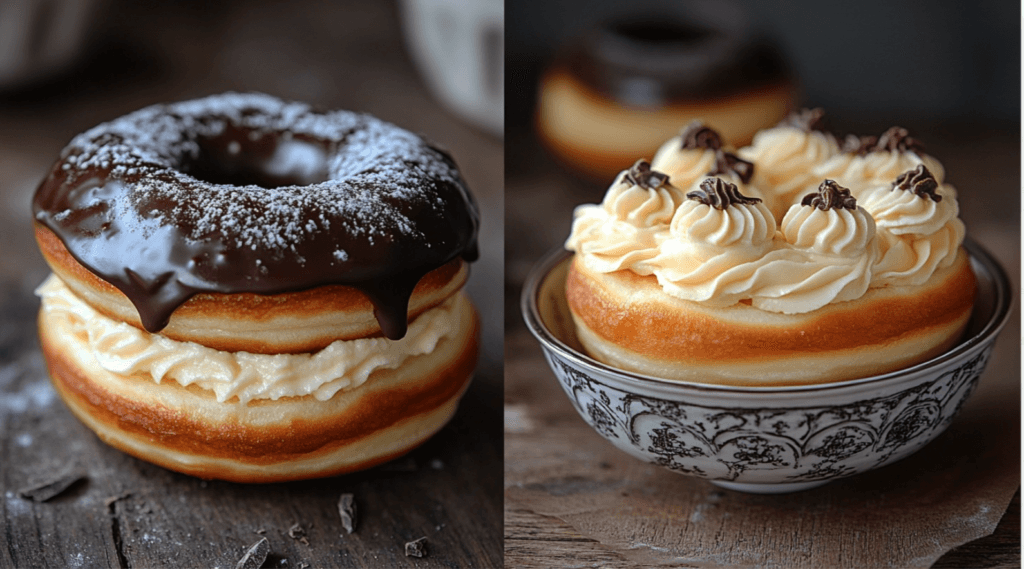I love desserts, especially those with creamy fillings. These fillings feel like they melt in your mouth. They take you to a world of sweet delight. But, have you ever thought about the differences between Boston cream and Bavarian cream? Let’s dive into their origins, ingredients, and what makes them special.
Boston cream and Bavarian cream might look similar at first. They are both creamy and custardy. But, they have different histories, textures, and uses in baking. Boston cream comes from the 1850s at the Parker House Hotel in Boston. It’s smooth and a bit runny. Bavarian cream, from 17th and 18th-century French cuisine, is thicker and richer because of heavy cream and gelatin.
Main Highlights :
- Boston cream and Bavarian cream are popular custard-based fillings for pastries, especially donuts.
- While they share similarities, they have distinct differences in texture, ingredients, and origins.
- Boston cream originated in the 1850s at the Parker House Hotel in Boston, while Bavarian cream has roots in 17th and 18th-century French cuisine.
- Boston cream has a silky smooth, slightly runny consistency, while Bavarian cream sets more firmly due to the use of heavy cream and gelatin.
Understanding Custard-Based Cream Fillings in Pastries
Custard-based cream fillings have a long history in baking. They started as simple milk and egg mixtures. Now, they’re a key part of many beloved pastries.
From Boston cream donuts to Bavarian cream cakes, these fillings are essential. They make these desserts creamy and indulgent.
The Evolution of Cream Fillings in Baking
These fillings have been around for centuries. Early recipes were just milk, eggs, and sugar. As baking got better, these custards turned into crème pâtissière or pastry cream.
They added thickening agents and more egg yolks. This made the filling richer and more stable. It could handle complex pastry designs.
Basic Components of Custard Creams
- Milk (whole milk or a mix of milk and cream for a richer texture)
- Egg yolks (for a thick, custardy consistency)
- Sugar (to balance the sweetness)
- Thickening agents (cornstarch, flour, or a mix)
- Flavorings (vanilla extract, citrus zest, or other spices)
- Butter (for added richness and shine)
These ingredients are the base of custard-based cream fillings. They’re used in many bakery desserts. From egg-based custards to pastry cream in cakes and pastries.

What is Boston Cream: Origins and Characteristics
The boston cream pie is a favorite American dessert. It has a long history, starting in the 1850s. It was first made at the Parker House Hotel in Boston, Massachusetts.
A French chef named Sanzian made the first one. Boston cream comes from old New England and Pennsylvania Dutch “pudding-cake pies.” It has a soft cake, creamy custard, and a chocolate glaze on top.
This mix of flavors and textures makes Boston cream popular. It’s a favorite in bakeries and cafes everywhere.
Boston cream is also found in Boston cream donuts. These donuts have the same creamy center and chocolate glaze. They’re a fun twist on the original.
Its delicious flavors and rich texture make it a classic American dessert.

Bavarian Cream: Traditional Recipe and Features
Bavarian cream is actually from French cuisine, not Bavaria. French chefs made it for Bavarian rulers in the 17th and 18th centuries. It’s thicker and richer than Boston cream, making it great for filling pastries.
Historical Background of Bavarian Cream
French chefs working for Bavarian nobility created Bavarian cream. They mixed custard with a thick, creamy texture. Now, it’s a key part of European desserts, enjoyed alone or in pastries.
Key Ingredients and Preparation Methods
- Milk
- Eggs
- Sugar
- Vanilla extract
- Heavy cream
- Gelatin
These ingredients make Bavarian cream thick and creamy. Enjoy it alone or in european vs american desserts, like bavarian cream cake.

Are Boston Cream and Bavarian Cream the Same
Boston cream and Bavarian cream may look similar, but they are not the same. They have different ingredients, textures, and uses. Knowing these differences helps you pick the best cream for your baking.
Boston cream is used in Boston cream pie. It’s a soft, runny custard made with vanilla and cornstarch. Bavarian cream, on the other hand, is thicker.
The texture affects how you serve these creams. Boston cream is best at room temperature or a bit chilled. Bavarian cream is served cold because of the gelatin. This makes it great for layered desserts and delicate pastries.

Main Differences in Texture and Consistency
When we talk about cream fillings in pastries, texture and consistency are key. Boston cream is thickened with cornstarch, making it silky and runnier. Bavarian cream, with heavy cream and gelatin, is thicker and richer.
Thickness and Stability Comparison
Bavarian cream is dense and mousse-like, great on its own. It holds its shape well. Boston cream is softer and more pourable. It’s best used as a filling and is sensitive to temperature.
Serving Temperature Variations
The serving temperature is another big difference. Bavarian cream is chilled, thanks to the gelatin. Boston cream can be enjoyed at room temperature or chilled, depending on taste.
Boston and Bavarian Cream are perfect for different desserts. Knowing their textures and serving temperatures helps choose the right filling for your creations.
Popular Desserts Using Boston Cream
Boston cream is a custard-based filling used in many classic American desserts. It’s most famous in the Boston cream pie. This is a layer cake filled with creamy custard and topped with chocolate glaze.
Boston cream is also great in Boston cream donuts. The soft dough and smooth cream are a perfect match. They’re even better with a chocolate coating.
Boston cream is used in other pastries too. It fills cream puffs and eclairs beautifully. The custard’s rich texture goes well with the choux pastry shell, making it a decadent treat.
| Dessert | Ingredients | Shelf Life |
|---|---|---|
| Boston Cream Pie | Yellow cake, butter, eggs, vanilla pudding, milk, heavy cream, chocolate chips | 4-5 days (refrigerated) |
| Boston Cream Donuts | Donut dough, Boston cream filling, chocolate glaze | 2 days (airtight container) |
| Cream Puffs | Choux pastry, Boston cream filling, powdered sugar | 3-4 days (refrigerated) |
Enjoy a Boston cream pie, a Boston cream donut, or a cream puff. Boston cream is a key part of many classic American desserts.
Classic Bavarian Cream Applications in Pastries
Bavarian cream is a rich custard filling loved in European desserts. It can be shaped or used as a filling, adding a smooth texture to pastries. It’s found in both old and new desserts, showing its flexibility.
Traditional European Desserts
Bavarian cream is a key part of European sweets. It’s often in trifles, with sponge cake, fruit, and liqueur. It also fills cream pies, adding luxury to the crust. Plus, it tops fruit tarts, enhancing their flavors.
Modern Adaptations in Bakery Products
Bavarian cream is also in today’s bakery items. In the U.S., it’s in donuts, with powdered sugar on top. It’s more adaptable than Boston cream, making it a favorite for bakers.
| Bavarian Cream Applications | European Desserts | American Bakery Products |
|---|---|---|
| Filling |
|
|
| Topping |
|
|
| Molded Shapes |
|
|
Bavarian cream has a long history in European desserts. It’s also popular in American bakeries. Its ability to adapt makes it great for many pastry types.
Making Both Creams at Home: Tips and Techniques
If you love custard fillings, you’ll be happy to know you can make Boston cream and Bavarian cream at home. Making these fillings is a fun and rewarding task. It’s great for impressing guests or adding a special touch to your pastries.
To make Boston cream, you need to mix eggs, sugar, and milk carefully. Cook this mix over medium heat, stirring constantly, until it thickens. Adding cornstarch makes the filling smooth and spreadable.
Bavarian cream is different because it uses gelatin. Gelatin gives it a light and airy texture. First, make the custard base. Then, bloom the gelatin in cold water and fold it into the warm custard. This makes the cream set right.
The cooling times for these creams vary. Boston cream is ready after a short chill. But Bavarian cream needs 2 to 4 hours in the fridge. This time lets the gelatin work its magic, making the cream dreamy.
Making Boston or Bavarian cream involves mixing, whisking, and cooking on medium heat. Stir constantly. With practice, you can make these custard delights at home.
| Cream Filling | Preparation Time | Chilling/Setting Time | Key Ingredient |
|---|---|---|---|
| Boston Cream | 15-20 minutes | At least 3 hours | Cornstarch |
| Bavarian Cream | 20-25 minutes | 2-4 hours | Gelatin |
Learning to make Boston and Bavarian cream gives you two great fillings. Use them to fill eclairs, layer cakes, or top desserts. These creams will impress and delight everyone.
Conclusion
Boston cream and Bavarian cream are both custard-based fillings. But they are different in many ways. Boston cream is runnier and great for donuts and cakes. Bavarian cream is thicker and works well in many desserts.
Boston cream comes from the United States. It’s lighter and perfect for filling donuts and cakes. It’s made with a sponge cake, pastry cream, and chocolate ganache. This mix is loved by many.
Bavarian cream, however, comes from Europe. It’s thicker and more stable. It’s made with whipped cream, milk, sugar, and egg yolks. This filling is great for many desserts because of its creamy texture.
Both Boston cream and Bavarian cream are special in their own ways. They offer unique tastes and textures. Whether you like Boston cream’s lightness or Bavarian cream’s creaminess, they both bring joy to baking.
FAQ
What is the difference between Boston cream and Bavarian cream?
Boston cream and Bavarian cream are both custard fillings. But they differ in texture and ingredients. Boston cream is runny and silky, made with milk, eggs, sugar, vanilla, and cornstarch.
Bavarian cream is thicker and richer. It’s made with heavy cream and gelatin, giving it a unique texture.
What is the origin of Boston cream?
Boston cream started in the 1850s at the Parker House Hotel in Boston. It comes from New England and Pennsylvania Dutch “pudding-cake pies.” It’s used in donuts and Boston cream pie.
What is the history of Bavarian cream?
Bavarian cream comes from French cuisine. It was made by French chefs for Bavarian rulers in the 17th and 18th centuries. It has milk, eggs, sugar, vanilla, heavy cream, and gelatin.
This mix makes it thicker and richer than Boston cream.
How are Boston cream and Bavarian cream used in desserts?
Boston cream is often in donuts and Boston cream pie. Its runny texture works well with cake or donuts.
Bavarian cream is more versatile. It can be molded or used in trifles, cream pies, and as a fruit tart topping. Its stability makes it great for creative desserts.
Can I make Boston cream and Bavarian cream at home?
Yes, you can make both at home. Mix ingredients and whisk vigorously. Cook on medium heat, stirring constantly.
For Boston cream, focus on a smooth consistency with cornstarch. For Bavarian cream, gelatin is key for the right texture.

